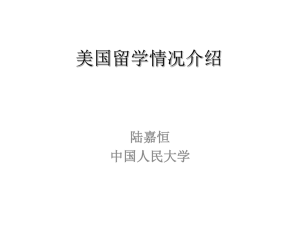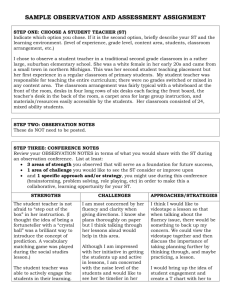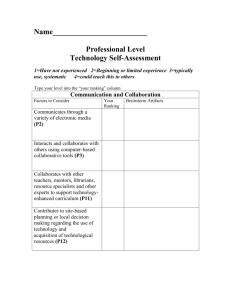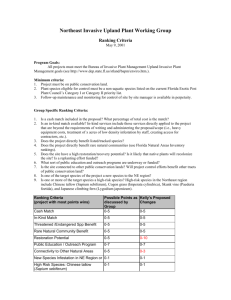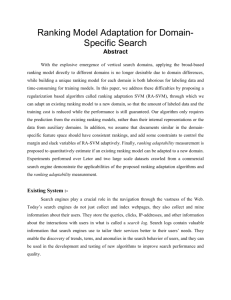The Academic Ranking of World Universities
advertisement
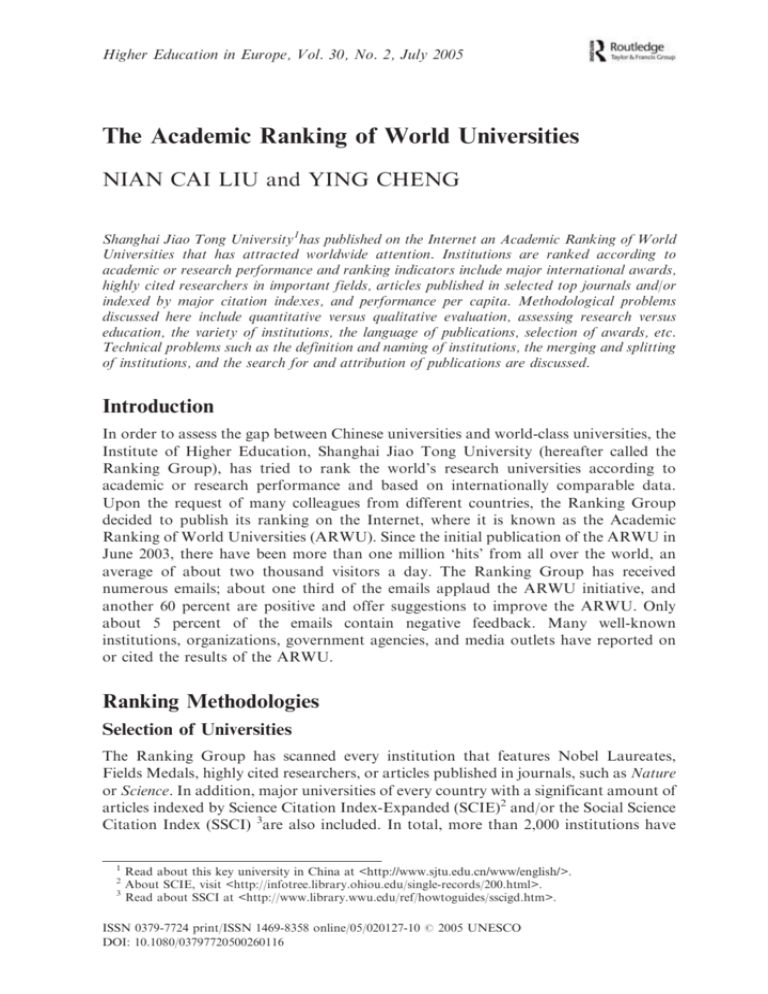
Higher Education in Europe, Vol. 30, No. 2, July 2005 The Academic Ranking of World Universities NIAN CAI LIU and YING CHENG Shanghai Jiao Tong University1has published on the Internet an Academic Ranking of World Universities that has attracted worldwide attention. Institutions are ranked according to academic or research performance and ranking indicators include major international awards, highly cited researchers in important fields, articles published in selected top journals and/or indexed by major citation indexes, and performance per capita. Methodological problems discussed here include quantitative versus qualitative evaluation, assessing research versus education, the variety of institutions, the language of publications, selection of awards, etc. Technical problems such as the definition and naming of institutions, the merging and splitting of institutions, and the search for and attribution of publications are discussed. Introduction In order to assess the gap between Chinese universities and world-class universities, the Institute of Higher Education, Shanghai Jiao Tong University (hereafter called the Ranking Group), has tried to rank the world’s research universities according to academic or research performance and based on internationally comparable data. Upon the request of many colleagues from different countries, the Ranking Group decided to publish its ranking on the Internet, where it is known as the Academic Ranking of World Universities (ARWU). Since the initial publication of the ARWU in June 2003, there have been more than one million ‘hits’ from all over the world, an average of about two thousand visitors a day. The Ranking Group has received numerous emails; about one third of the emails applaud the ARWU initiative, and another 60 percent are positive and offer suggestions to improve the ARWU. Only about 5 percent of the emails contain negative feedback. Many well-known institutions, organizations, government agencies, and media outlets have reported on or cited the results of the ARWU. Ranking Methodologies Selection of Universities The Ranking Group has scanned every institution that features Nobel Laureates, Fields Medals, highly cited researchers, or articles published in journals, such as Nature or Science. In addition, major universities of every country with a significant amount of articles indexed by Science Citation Index-Expanded (SCIE)2 and/or the Social Science Citation Index (SSCI) 3are also included. In total, more than 2,000 institutions have 1 2 3 Read about this key university in China at <http://www.sjtu.edu.cn/www/english/>. About SCIE, visit <http://infotree.library.ohiou.edu/single-records/200.html>. Read about SSCI at <http://www.library.wwu.edu/ref/howtoguides/sscigd.htm>. ISSN 0379-7724 print/ISSN 1469-8358 online/05/020127-10 DOI: 10.1080/03797720500260116 # 2005 UNESCO 128 N. CAI LIU AND Y. CHENG been reviewed, and about one thousand have actually been ranked. A list of the top five hundred institutions has been published on the Internet. Ranking Criteria and Weights As above, higher education institutions are ranked according to their academic or research performance, using indicators such as alumni and staff who have won Nobel Prizes and Fields Medals, highly cited researchers in twenty one broad subject categories, articles published in Nature and Science, articles indexed in SCIE or SSCI, and academic performance relative to institutional size. Table 1 gives the details of the criteria and their weights. Definition of Indicators Alumni indicates the total number of the alumni of an institution who have won Nobel Prizes and Fields Medals. Alumni are defined as those who obtained Bachelor’s, Master’s, or Doctor’s degrees from the institution. Different weights are set, according to the periods of obtaining degrees: the weight is 100 percent for alumni obtaining degrees in 1991–2000, 90 percent for alumni obtaining degrees between 1981 and 1990, 80 percent for alumni obtaining degrees in 1971–1980, and so on; finally, 10 percent for alumni obtaining degrees in 1901–1910. If a person obtains more than one degree from an institution, the institution is considered once only. Award indicates the total number of staff members of an institution who have won Nobel prizes in Physics, Chemistry, Medicine and Economics, and Fields Medals in Mathematics. By staff is meant those who worked at the institution in question at the time of winning the prize. Again, different weights are set, according to period: the weight is 100 percent for winners between 2001 and 2003, 90 percent for winners between 1991 and 2000, 80 percent for winners between 1981 and 1990, 70 percent for winners between 1971 and 1980, and so on; finally, 10 percent for winners between 1911 and 1920. If a winner is affiliated with more than TABLE Criterion Quality of education Quality of faculty Research output Size of institution Total 1. Criteria and weights for the 2004 ARWU Indicator Alumni of an institution winning Nobel Prizes and Fields Medals Staff of an institution winning Nobel Prizes and Fields Medals Highly cited researchers in 21 broad subject categories Articles published in Nature and Science Articles Indexed in SCIE and/or SSCI Academic performance relative to institutional size Code Weight (percentage) Alumni 10 Award 20 HiCi 20 N&S* SCI 20 20 Size 10 100 * For institutions specialized in the Humanities and Social Sciences, such as the London School of Economics, N&S is not considered, and the weighting redistributed to other indicators. Source: The authors and <http://ed.sjtu.edu.cn/ranking.htm>. THE ARWU 129 one institution, each institution is assigned the prize. For Nobel prizes, if a prize is shared by more than one person, weights are set for the winners according to their proportion of the prize. HiCi indicates the number of highly cited researchers in 21 broad subject categories in Life Sciences, Medicine, Physical Sciences, Engineering, and Social Sciences. Such individuals will be among the most highly cited researchers within each category. The definition of categories, and detailed procedural information, can be found on the website of the ISI Web of Knowledge4 of Thomson Corporation. N&S indicates the number of articles published in Nature and Science in the past five years. To distinguish the order of author affiliation, a weight of 100 percent is assigned to corresponding author affiliation, 50 percent to first author affiliation (second author affiliation if the first author affiliation is the same as corresponding author affiliation), 25 percent to the next author affiliation, and 1 percent to all other author affiliations. Only publications of article type are considered. SCI indicates the total number of articles indexed by Science Citation IndexExpanded and/or the Social Science Citation Index in the previous year. Again, only publications of article type are considered. Size indicates the total scores of the above five indicators divided by the number of full-time equivalent (FTE) academic staff. If the number of academic staff in a given institution cannot be obtained, the weighted total score of the above five indicators is used. For the 2004 ARWU, the number of FTE academic staff was obtained for institutions in the USA, China (mainland), Italy, the Netherlands, Sweden, Belgium, etc. Scoring Procedures For each indicator, the highest scoring institution is assigned a score of 100, and the subsequent institutional scores are calculated as a percentage of the top score. The distribution of data for each indicator is examined for any significant distorting effect, and standard statistical techniques are used to adjust the indicator if necessary. Scores for each indicator are weighted to arrive at a final, overall score for an institution. The overall highest scoring institution is assigned a total score of 100, and other institutions are assigned a score calculated as a percentage of the top total score. The scores are then placed in descending order, i.e., an institution rank reflects the number of institutions that sit above it. Statistics and Analysis The Statistics of Ranking Table 2 indicates the number and percentages of top institutions by region. North and South America feature 85 percent of the top 20 institutions, and 55 percent of the top 100 institutions. For the top 400 and top 500 institutions, the number of European institutions is slightly greater than that of North and South American institutions. The 4 <http://www.isiknowledge.com>. 130 N. CAI LIU AND Y. CHENG TABLE 2. Number and percentage of top institutions by region Region North and South America Europe Asia/Pacific Top 20 Top 100 Top 200 Top 300 Top 400 Top 500 17 (85.0%) 2 (10.0%) 1 (5.0%) 55 (55.0%) 37 (37.0%) 8 (8.0%) 101 (50.2%) 79 (39.3%) 21 (10.5%) 138 (45.9%) 125 (41.5%) 37 (12.3%) 1 (0.3%) 164 (40.7%) 171 (42.4%) 66 (16.4%) 2 (0.5%) 200 (399%) 209 (41.6%) 89 (17.7%) 4 (0.8%) 20 100 201 301 403 502 Africa Total Source: The authors and <http://ed.sjtu.edu.cn/ranking.htm>. percentage of higher education institutions in the Asia/Pacific region is less than 20 percent in any range. The distribution of top institutions among countries is also interesting. As shown in Table 3, the top 500 institutions are found in only 35 countries. The USA has a dominant position, with 85 percent of the top 20 institutions, 51 percent of the top 100 institutions, and 45 percent of the top 200 institutions. The United Kingdom performs well, with about 10 percent of the top institutions in all of the ranges. It is worth noting here that most of the top institutions are to be found in developed countries, which is indicative of the importance of economic power in building world-class universities. Distribution of Scores The distribution of total scores is shown in Figure 1. There is a rapid decrease in the total score relative to rank for the top 100 institutions, and particularly for the top 50. The change of total score is relatively small in the range of the rankings from 100 to 500. This is also why the ranking results are published in groups of 50 institutions in the range of rankings 100 to 200, but in groups of 100 institutions in the range of rankings 200 to 500. Correlation Coefficients Table 4 shows the correlation between indicator scores for the top 500 institutions. All of the correlation coefficients between the total score and the score of each indicator are above 0.80. The scores of different indicators also correlate well among themselves with correlation coefficients higher than 0.50, indicating that the set of indicators is a compact and coherent one. Average Values of Indicators In Table 5, the average values of selected indicators are shown, with reference to institutions ranked in different ranges. On average, an institution in the top 20 has 8.5 alumni and 4.4 staff winners of Nobel Prizes and Fields Medals, and 56.5 highly cited researchers. An institution ranked in the range of 101–201 has an average of 0.4 alumni 131 THE ARWU TABLE Country 1 2 3 4 5 6 7 8 9 10 11 12 13 14 15 16 17 18 19 20 21 22 23 24 25 26 27 28 29 30 31 32 33 34 35 3. Number of top institutions by country Top 20 Top 100 Top 200 Top 300 Top 400 Top 500 United States United Kingdom Japan Germany Canada France Sweden Switzerland Netherlands Australia Italy Israel Denmark Austria Finland Norway Russia Belgium China South Korea Spain Brazil Singapore Mexico New Zealand South Africa Hungary Ireland India Argentina Greece Poland Czech Chile Portugal 17 2 1 51 11 5 7 4 4 4 3 2 2 1 1 1 1 1 1 1 90 18 9 17 9 8 6 6 7 6 5 3 3 1 1 1 1 4 1 1 1 1 1 1 119 29 13 27 16 13 9 6 10 8 10 4 4 3 2 1 1 6 6 2 2 1 1 1 2 1 1 1 1 1 139 35 26 37 19 20 9 7 11 11 16 6 5 4 4 3 2 7 13 5 4 3 2 1 2 2 1 1 1 1 2 2 1 1 170 42 36 43 23 22 10 8 12 14 23 7 5 5 5 4 2 7 16 8 9 4 2 1 3 4 3 3 3 1 2 2 1 1 1 Total 20 100 201 301 403 502 Source: The authors and <http://ed.sjtu.edu.cn/ranking.htm>. and 0.1 staff winning Nobel Prizes and Fields Medals, and only 5.3 highly cited researchers. Methodological Problems and Solutions Qualitative versus Quantitative There is an understandable concern regarding whether the quality of any student experience or learning can be precisely measured by scores. However, universities and professors continue to score their students and the latter are usually informed that they will not be judged by scores exclusively; both the university and potential employers can make other sophisticated, independent judgments. 132 N. CAI LIU AND Y. CHENG Figure 1. Source: The authors and ,http://ed.sjtu.edu.cn/ranking.htm.. Similarly, there is always the question whether the quality of universities can be precisely measured by mere numbers and scores. Interested parties should therefore be cautious about any ranking and should not rely on any ranking exclusively, including the 2004 ARWU. Users should see rankings simply as one kind of reference, and make their own judgments regarding ranking results and indeed ranking methodologies. TABLE 4. Correlation coefficients between scores of indicators for 500 institutions Correlation Total Score Score on Alumni Score on Award Score on HiCi Score on N&S Total Score Score on Alumni Score on Award Score on HiCi Score on N&S Score on SCI Score on Size 1.00 0.80 0.84 0.90 0.93 0.81 0.83 1.00 0.76 0.60 0.67 0.55 0.68 1.00 0.65 0.70 0.50 0.73 1.00 0.86 0.68 0.70 1.00 0.74 0.77 Score on Score on SCI Size 1.00 0.56 1.00 Source: The authors and <http://ed.sjtu.edu.cn/ranking.htm>. TABLE Ranking Range Number Number Number Number Number 5. Average values of selected indicators Top 20 of of of of of Alumni Award HiCi N&S SCI 8.5 4.4 56.5 27.6 4316 21–100 1.6 0.6 13.6 6.7 2390 101–201 0.4 0.1 5.3 2.7 1578 202–301 0.2 0.0 2.3 1.5 1062 302–403 404–502 0.2 0.0 1.0 0.7 787 0.0 0.0 0.8 0.4 572 Source: Raw data of Academic Ranking of World Universities – 2004, published by the authors. THE ARWU 133 Education versus Research Different stakeholders have different expectations about quality, and the quality of higher education institutions is not easy to measure or compare on an international basis. It would be impossible to rank the quality of university education worldwide, owing to the huge differences between universities and the large variety of countries, and because of the technical difficulties inherent in obtaining internationally comparable data. If one wants to construct a reliable ranking of the world’s universities, the only possible ranking will be a comparative display of research performance. This is why the Ranking Group chose to rank the world’s research universities by their academic or research performance, based on internationally comparable and easily verifiable data. No subjective measures were taken, and no data is obtained from any kind of university report. Type and Size of Institutions Many well-known institutions specialized in the Humanities and Social Sciences are ranked relatively low, partly because of the imbalance in the production of scholarly articles between various subject fields. This may explain, for example, why the nominal performance of institutions with Medicine faculties appears better in the ranking relative to institutions specialized in the Humanities and Social Sciences. The Ranking Group tried hard, yet unsuccessfully, to find additional indicators that are specific to the Humanities and Social Sciences. Accordingly, the indicator N&S was not considered for institutions specializing in the Humanities and Social Sciences in the 2004 ARWU; its weighting was relocated to other indicators. The Ranking Group is studying the possibility of setting special weighting for articles indexed by the SSCI, and for institutions with Medicine faculties. The weighting of the Size indicator is rather low, but large institutions have relatively high positions in the ranking. The Ranking Group is studying the possibility of providing separate rankings with and without the size indicator. For ranking that includes the Size indicator, the weighting of the Size indicator could be as high as 50 percent. Furthermore, there are difficulties in defining ‘academic staff’ and in obtaining internationally comparable data. The Language and Type of Publications Since English is the international language of the academic world, scholars in Englishspeaking institutions are more closely integrated into the global academic environment than those outside the English-speaking world. As a result, university rankings based on research performance may inevitably lead to a bias against institutions outside the English-speaking world. One possible solution would be to assign a special weighting to publications in non-native languages. Only publication of the ‘original article’ type was considered for the 2004 ARWU. Papers of ‘communication’ type are important sources of original research but were not considered, on the assumption that most of the work in communications is eventually published in articles. Academic books also constitute important sources of original research, and are more common in some research fields than in others. These were not considered due to the technical difficulties in obtaining internationally comparable data. 134 N. CAI LIU AND Y. CHENG Selection of Awards and Experience of Award Winners There are many well-known awards, such as the Nobel Prize, the Fields Medal, the Abel Prize, and the Pulitzer Prize. However, the Nobel Prize and the Fields Medal are most widely recognized by the international academic community. Some concerns arise regarding the work setting of award winners, in that the latter may receive awards at or from institutions other than the one where the research was done. Similarly, the institutions where award winners obtained their degrees and those where they spent most of their study time may not be the same. In addition, postdoctoral training and other non-degree training is not considered. Technical Problems and Solutions Definition of Institutions Institutions of the multi-campus university systems of the United States are treated as separate institutions, according to the Integrated Postsecondary Education Data System of the National Center for Education Statistics and to the Carnegie Classification of Institutions of Higher Education. For example, the University of California at Los Angeles (UCLA) is ranked as an independent institution; similarly, the University of London’s Imperial College is ranked separately. Institutions or research organizations affiliated to a university are treated according to the information in author affiliations. If authors identify themselves as members of a university in their affiliations, this will be considered accordingly in the ranking. Typical examples include the École Polytechnique of Montreal, affiliated to the University of Montreal (Canada); and the CNRS laboratories affiliated to French universities. Hospitals affiliated to universities present a complex challenge in many countries. Some hospitals do not wish to include the university name in their affiliation, while some universities do not wish to include papers published by hospital staff in their statistics. Therefore, hospitals affiliated to universities are also treated or included according to authors’ stated affiliations. Furthermore, it is the responsibility of the universities and their affiliated units to state the proper affiliations in their publications, not that of database manufacturers and users. Naming of Institutions Many universities have more than one commonly used name. In France, for example, the Universite´ de Paris 6 is also called Universite´ Pierre & Marie Curie. In the United States, Virginia Tech is also known as Virginia Polytechnic and State University. In China, the traditional spelling of names is used for a number of institutions, such as Tsinghua University for Qinghua University. For institutions in non-English speaking countries, there often exist different names for the same institution or the same name for different institutions due to variations in translation. For example, the Universite´ Libre de Bruxelles and Vrije Universiteit Brussel in Belgium share the same English name, Free University of Brussels. Universittat zu Köln in Germany may be translated to University of Koeln or University of Cologne. THE ARWU 135 Abbreviated names are commonly used for a large number of institutions. For example, ETHZ is used for the Swiss Federal Institute of Technology of Zurich; UMPC is used for Universite´ de Paris 6 in France. Merging and Splitting of Institutions The names of institutions also change significantly as a result of merging, splitting, closure, and re-naming. For example, Berlin University had several Nobel Prize winners before the Second World War. Today, both Humboldt University of Berlin and the Free University of Berlin may lay claim to inheriting the Nobel Prizes of the Berlin University for ranking purposes. The names of institutions continue to change; the University of Manchester and UMIST in the United Kingdom merged into one institution in October 2004. The University of Kwazulu-Natal in South Africa resulted from a merger between the University of Natal and the University of Durban-Westville in January 2004. The University of Innsbruck in Austria has recently split into two independent universities, the University of Innsbruck and the Innsbruck Medical University. Database Searching and the Attribution of Publications Great care must be exercised when using keywords, particularly regarding institutions in the same city. For example, if one simply searches for ‘Beijing University’, he or she would obtain results for a dozen universities in the city of Beijing. For its incorporation of highly cited researchers, the Ranking Group downloaded the full list from the ISI database and identified the affiliation of every researcher one by one. Researchers from a department, institute or school of a university who did not mention the university in their affiliation were carefully re-attributed to the right university. For articles published in Nature and Science, the Ranking Group searched the ISI database country by country and counted every article one by one. Again, articles associated with a department, institute or school of a university were carefully attributed to the right university. For articles indexed in the SCIE and/or SSCI, the Ranking Group pursued every possible means to find solutions for the apparent problems, and succeeded in solving most of them. Concluding remarks Any ranking exercise is controversial, and no ranking is absolutely objective. Nevertheless, university rankings have become popular in many countries. Whether or not universities and other organizations approve of or agree with the various ranking systems, clearly the latter are here to stay. The key issue then is how to improve ranking systems for the benefit of higher education as a whole. The ARWU is academic research driven by personal interest, and is carried out independently without any external support. It makes use of carefully selected, nonsubjective criteria, and of internationally comparable data that most users can verify in some way. It provides ranking results in groups of 50 or 100 for institutions ranked 100–500, taking into account the significance of difference in scores. 136 N. CAI LIU AND Y. CHENG The Ranking Group will continue its efforts to update the ARWU annually and to make necessary modifications and improvements. The Ranking Group is investigating the possibility of providing lists of top universities with an Engineering (Technology) or Medical orientation, as well as that of ranking universities by broad subject areas such as Social Sciences, Physical Sciences, Engineering and Technology, Life Sciences, and Medicine. References INSTITUTE OF HIGHER EDUCATION, SHANGHAI JIAO TONG UNIVERSITY. Academic Ranking of World Universities – 2004. Available at <http://ed.sjtu.edu.cn/ranking.htm>.

